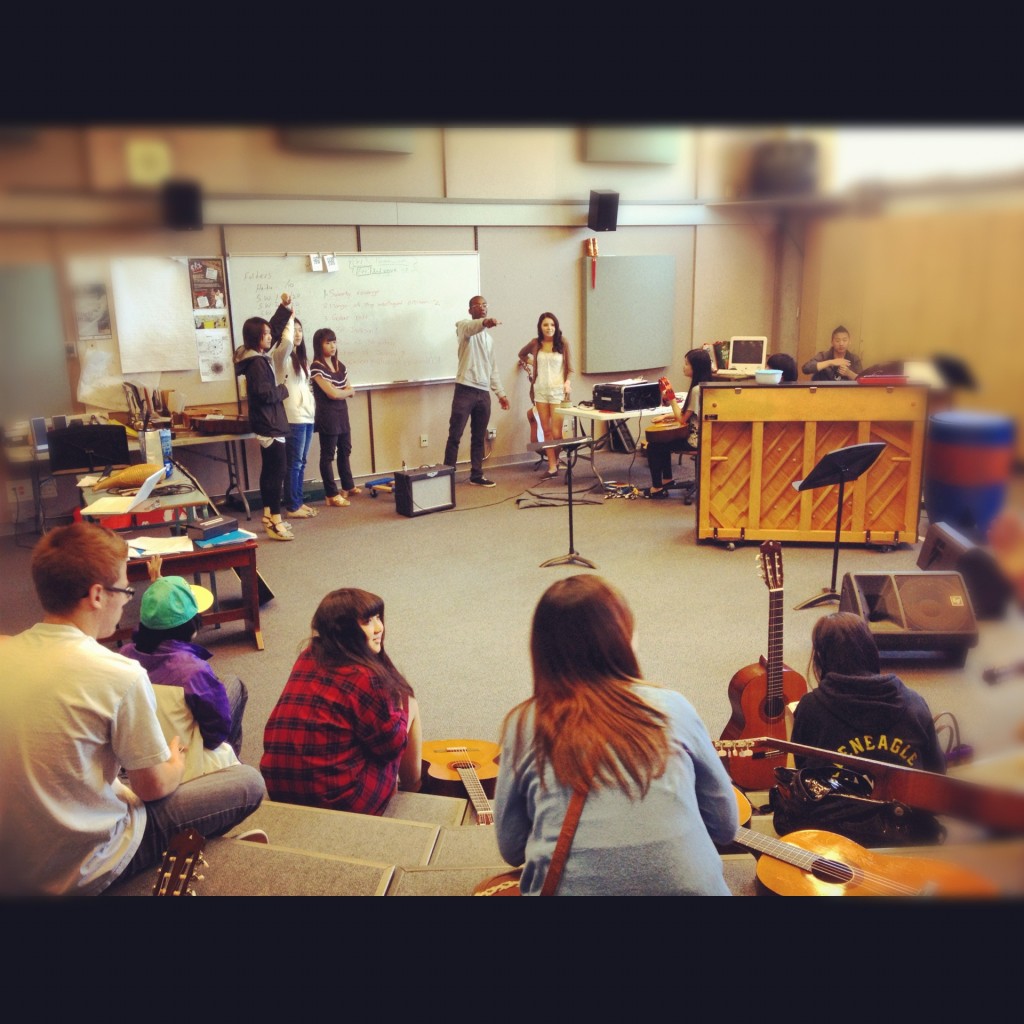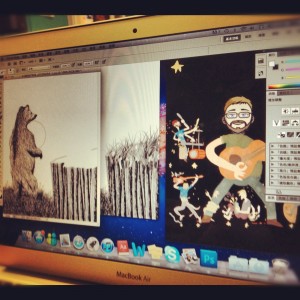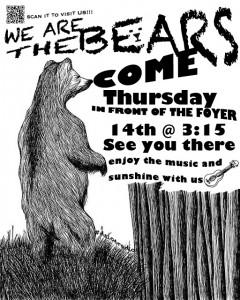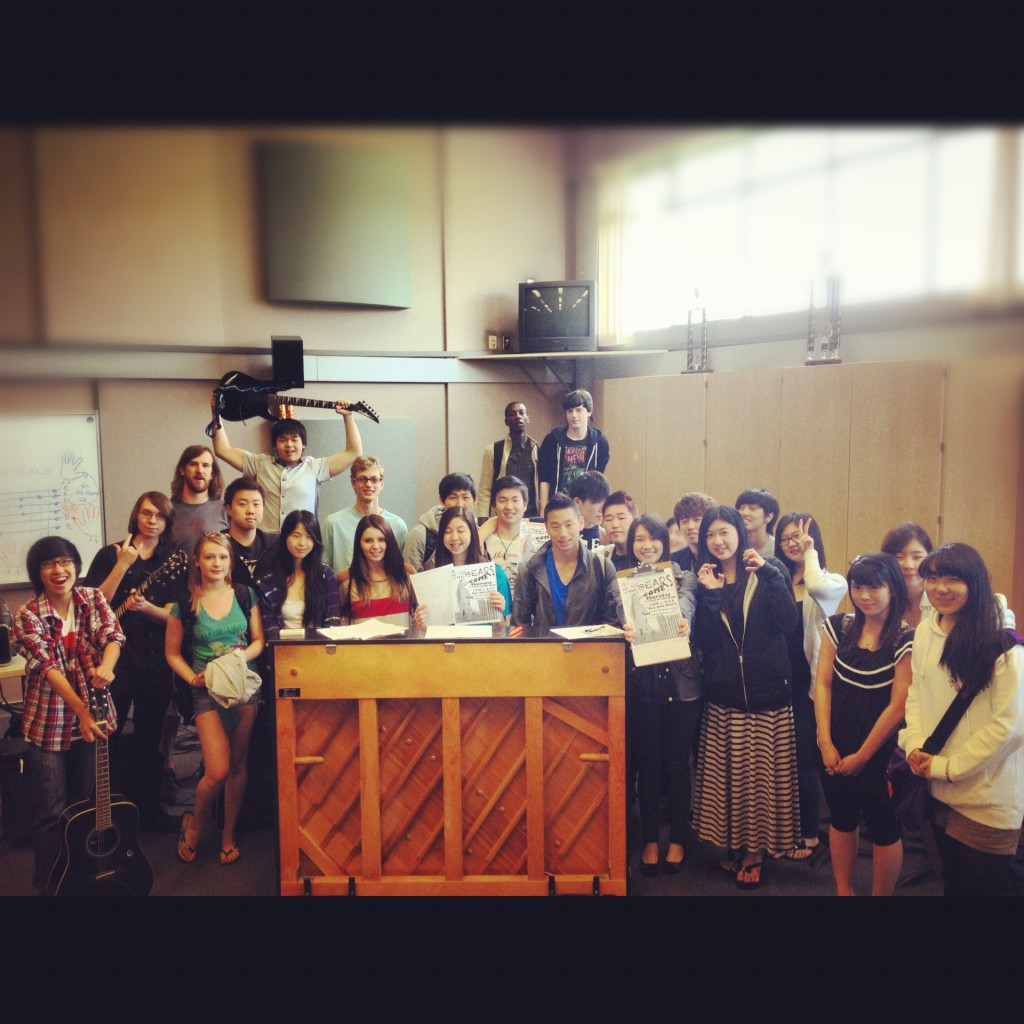You can check out the Storify tracking the Social Media progressions of the project here.

In what unconsciously turned out to be a culmination of the Fall’s Learning in Public project, guitar class this spring challenged a group of individuals to create and rally around a mutually agreed-upon idea for a new kind of class activity. Nothing overly complex, the Bears became an elemental symbol around which we were able to create a basic, guitar based rock and roll band that brought diverse classroom traits and talents to the forefront of our daily work.
Let me state here that I have little formal training as a music teacher, have never really played in a band (save a few student groups where I served much more an eager sponsor-teacher than bandmate), let alone led one, and had no idea throughout the process whether the endeavour would be successful, let alone what direction it might take on a given day.Initially, the class formed into small groups that functioned as committees responsible for various elements of the band’s life cycle: project management, branding, media, songwriting, arrangement. What the band became, every step of the way, would be built out of an individual and collective commitment to the cause: that of the continual creation of the band.
Not that these aren’t all things I was and am passionate to discover. This year my own musical growth has snowballed toward just such a learning opportunity, allowing me to frame my role as ‘teacher’ during the process as that of ‘lead learner,’ something we hear and talk about a lot as teachers, but which can be difficult to create deliberately. In this case, my purposeful treading of water mostly consisted of the necessity of keeping the project moving forward the only ways I knew how: creating opportunities for each of the committees, and the individuals composing them, to imagine a possible next step for the project, and then motivate and guide them in carrying it out.
This all being said, the success of the band was in the hands of the class as much as I could make it; I made an agreement with them – not unlike one that I feel like I make in most classes, but in this case it was explicit: so long as we all acknowledge that we can create something special here, I am going to hold you to the goals that you each set for yourselves to be a part of that process.
Whether we are successful or not has less to do with my expectations of the individuals in my class than my facilitation of the learning experience, where ideally each learner holds themselves to their own expectations.

What I’ve found that this ‘agreement’ helps bring about is an environment that is able to capitalize on the unique talents in the room. Once the band got going, people learned to arrange mic cables and amplifiers to maximize the effect of our sound; others wrote songs, led rehearsals, and created a logo for the newly minted Bears (that we eventually screened on T-shirts); various members of the band ran around with a videocamera, or various iPhones and iPads, to record and document the process, and on the second to last day of the year – following the chaos of locker-cleanout – we promoted and played a gig in the front entrance of the school that people had been alerted to by awesome hand-drawn fliers (complete with QR codes linking to the band’s Facebook page).
All of this happened in five weeks, during which I was away for a week on a TALONS class trip, and many members of the class were preparing to graduate high school. Like Ray Manzarek said of the year he and Jim Morrison formed the Doors, “we had a strange visitation of the energy,” an energy that is the intangible vibration of musical community and communication.

I start each guitar semester by telling my classes that humans evolved a wiring to participate in music; that our ability to stomp our feet, beat drums or chant in concert and unison literally set our ancestors apart from others who might not be so in tune (pardon the pun) with one another, and that communicating in music established the pathways and connections in our brains that eventually allowed us to develop language, and begin to know ourselves and one another in ways that would have been previously unimaginable.
On those first days of guitar every semester, we usually begin by snapping our fingers in time with one another, or passing bean bags through the air to a shared rhythm to learn one another’s names. I tell them that the ability to sync up like this is so innate that a person will be able to more exactly join in rhythm with another person than with a device like a metronome, and that when we make music with others, we are communicating in the oldest of ways, reaching back into the fabric of what makes us us, and creating something that is in ways universal, and at the same time deeply personal.
There is a momentum to performing live music that members of the group need to each be responsible for, the essence of musical connection that allows other players, and an audience to participate in the raw energy that the intersection of rhythm and melody is capable of creating.
This is a skill only learned by doing.
In the video of the Bears final performance, the band struggles to hear one another in the fray and excitement of the crowd and the moment, and the bass and drums are a bar ahead of the rest of the band until the first chorus. They/we work this out though, and as “We are the Bears” reaches its musical climax – in the moment between Sarah calmly saying, “Step away, bro,” and Kevin’s blistering guitar solo kicking in – the monthlong project’s goal is realized: the band has created a moment of visceral rock and roll, and brought it to their audience.
For the students in the band – not to mention their teacher – this is an incredible power to discover, and begin to wield, something I talked about with Brian Lamb and Giulia Forsythe after this year’s Northern Voice jam-after party in Vancouver: how to collectively keep the ball – the energy, the timing, the essence of a song – in the air between so many different hands, and how this is a visible skill when playing or watching music, but finds its way into so many different aspects of life, learning and the relationships we form with other people.
On the last day of class, many of the Bears made a point of hanging around for a few minutes to take pictures with one another, shake my hands and otherwise linger in the magical atmosphere the guitar classroom had been transformed into by their efforts.
“This class was more than a class,” one of the young men who was graduating told me on his way out the door. “Just what it was, I’m not sure. But it was pretty great.”
Hopefully we all spend the next little while trying to put our finger on just what it was, and how we can each do it again.



This is, without a doubt, one of the most exciting and meaningful projects I have seen for a long time. If they do not realize know what a special experience it was, it will grow on them as years pass, and will give them a foundation for going forward in an educational system where they know sometimes they can be part of the process of designing their own learning.
You may not consider yourself an accomplished teacher if music, but I will encounter having learned some songs from you, but what you do so well is enable people to rise above what they think they can do.
Rock on, Bears!
Thanks, Alan, for the wonderful comment. One of the only things I was clinging to as a ‘Success’ benchmark throughout the project was that one day, in ten years, two people from Guitar class who weren’t really friends, maybe who weren’t even in the same grade, would see each other at the bank, or in the mall, or maybe a local tavern, and say to one another, “Remember that crazy thing we did in guitar?”
I think it’s safe to say that there’ll be at least a few of those conversations, which is good enough for me in the meantime.